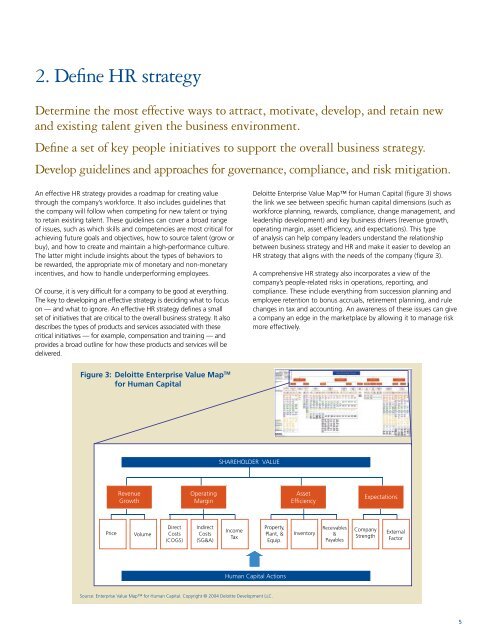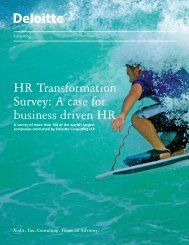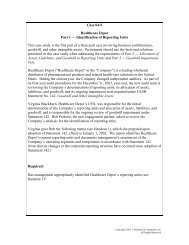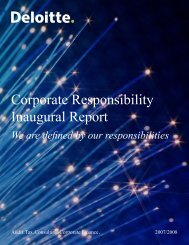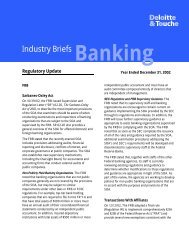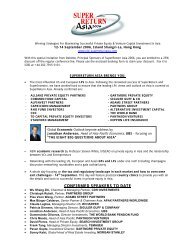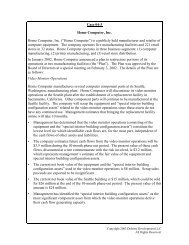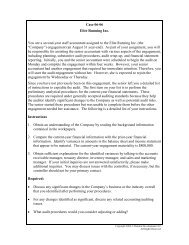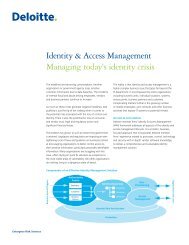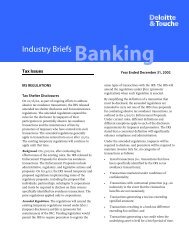1. Understand business strategyUnderstand cus<strong>to</strong>mer needs, market forces, and trends. Model <strong>the</strong>ir impac<strong>to</strong>n resource planning and workforce performance.Understand business strategy and strategic priorities. Plan and model <strong>the</strong>impact on resource planning and workforce growth.Understand <strong>the</strong> implications of <strong>the</strong> overall business strategy and marketenvironment on governance, compliance, and risk.Different business strategies require different workforce strategies.How a company chooses <strong>to</strong> compete — and <strong>the</strong> current and projectedstrengths and weaknesses of its talent pool — will largely dictate <strong>the</strong>kinds of human capital investments and actions necessary <strong>to</strong> achievedesired results in <strong>the</strong> marketplace. For example, a strategy based oninnovation has different workforce requirements than a strategy basedon outstanding cus<strong>to</strong>mer service <strong>level</strong>s or low prices. Similarly, anorganic growth strategy requires very different people practices thanan aggressive growth strategy based on mergers and acquisitions.A company’s <strong>HR</strong> strategy, just like its overall business strategy, mustbe grounded in a solid understanding of market forces and trends.In developed countries, demographic trends, such as Baby Boomerretirements, aging workforces, and a declining interest in science andtechnology education, are creating a chronic shortage of critical talent.At <strong>the</strong> same time, <strong>the</strong> labor pool is becoming increasingly global,driven by new workplace practices and technologies that make itpossible <strong>to</strong> tap talent pools that were previously inaccessible.In addition, actions taken by cus<strong>to</strong>mers, competi<strong>to</strong>rs, and supplierscan have a big impact on a company’s workforce requirements. Forexample, as competition in <strong>the</strong> telecommunications industry continues<strong>to</strong> squeeze profits, companies are steadily shifting <strong>the</strong>ir operations <strong>to</strong>lower-cost offshore locations. Similarly, in <strong>the</strong> technology sec<strong>to</strong>r, <strong>the</strong>emergence of high-profile companies is forcing incumbents <strong>to</strong> findnew ways <strong>to</strong> attract and retain <strong>to</strong>p talent.When developing an <strong>HR</strong> strategy, all of <strong>the</strong>se forces and trends mustbe fac<strong>to</strong>red in<strong>to</strong> <strong>the</strong> equation. Figure 2 shows a simple, but effectiveframework <strong>to</strong> help <strong>HR</strong> align its strategies and capabilities with <strong>the</strong>strategies and priorities of <strong>the</strong> company.Figure 2: Aligning <strong>HR</strong> with <strong>the</strong> Company (case study):CEO PerspectiveBusiness StrategyBusiness Plan• Scale and scope for a consolidatingtelecommunications industry• Innovation leader delivering comprehensiveportfolio of products, services and solutions• Unique position <strong>to</strong> compete effectivelyagainst competition• Achieve €1.5Bn cost synergies by 2010• Double digit operating margin in <strong>the</strong> first year• Drive savings and targets• Regula<strong>to</strong>ry and reporting compliance• Talent retention<strong>HR</strong> Strategy• Aid transition and enable business <strong>to</strong> achievestrategic goals and targets• Uncertainty from rapid changes• Reducing costs and increasing revenue whileretaining talent• Reducing IT and business complexity andredundancy<strong>HR</strong> Business Plan• An efficient, effective, flexible and compliant<strong>HR</strong> that provides integrated service delivery• An <strong>HR</strong> cost structure that supports expansionin<strong>to</strong> low cost countries• An <strong>HR</strong> Service Delivery Model <strong>to</strong> handle M&A,downsizing or <strong>the</strong> acquisition of groups ofemployeesC<strong>HR</strong>O PerspectiveSource: <strong>Deloitte</strong> Consulting strategic analysis for a telecommunications client.4
2. Define <strong>HR</strong> strategyDetermine <strong>the</strong> most effective ways <strong>to</strong> attract, motivate, develop, and retain newand existing talent given <strong>the</strong> business environment.Define a set of key people initiatives <strong>to</strong> support <strong>the</strong> overall business strategy.Develop guidelines and approaches for governance, compliance, and risk mitigation.An effective <strong>HR</strong> strategy provides a roadmap for creating valuethrough <strong>the</strong> company’s workforce. It also includes guidelines that<strong>the</strong> company will follow when competing for new talent or trying<strong>to</strong> retain existing talent. These guidelines can cover a broad rangeof issues, such as which skills and competencies are most critical forachieving future goals and objectives, how <strong>to</strong> source talent (grow orbuy), and how <strong>to</strong> create and maintain a high-performance culture.The latter might include insights about <strong>the</strong> types of behaviors <strong>to</strong>be rewarded, <strong>the</strong> appropriate mix of monetary and non-monetaryincentives, and how <strong>to</strong> handle underperforming employees.Of course, it is very difficult for a company <strong>to</strong> be good at everything.The key <strong>to</strong> developing an effective strategy is deciding what <strong>to</strong> focuson — and what <strong>to</strong> ignore. An effective <strong>HR</strong> strategy defines a smallset of initiatives that are critical <strong>to</strong> <strong>the</strong> overall business strategy. It alsodescribes <strong>the</strong> types of products and services associated with <strong>the</strong>secritical initiatives — for example, compensation and training — andprovides a broad outline for how <strong>the</strong>se products and services will bedelivered.<strong>Deloitte</strong> Enterprise Value Map for Human Capital (figure 3) shows<strong>the</strong> link we see between specific human capital dimensions (such asworkforce planning, rewards, compliance, change management, andleadership development) and key business drivers (revenue growth,operating margin, asset efficiency, and expectations). This typeof analysis can help company leaders understand <strong>the</strong> relationshipbetween business strategy and <strong>HR</strong> and make it easier <strong>to</strong> develop an<strong>HR</strong> strategy that aligns with <strong>the</strong> needs of <strong>the</strong> company (figure 3).A comprehensive <strong>HR</strong> strategy also incorporates a view of <strong>the</strong>company’s people-related risks in operations, reporting, andcompliance. These include everything from succession planning andemployee retention <strong>to</strong> bonus accruals, retirement planning, and rulechanges in tax and accounting. An awareness of <strong>the</strong>se issues can givea company an edge in <strong>the</strong> marketplace by allowing it <strong>to</strong> manage riskmore effectively.Figure 3: <strong>Deloitte</strong> Enterprise Value Map TMfor Human CapitalSHAREHOLDER VALUERevenueGrowthOperatingMarginAssetEfficiencyExpectationsPriceVolumeDirectCosts(COGS)IndirectCosts(SG&A)IncomeTaxProperty,Plant, &Equip.Inven<strong>to</strong>ryReceivables&PayablesCompanyStrengthExternalFac<strong>to</strong>rHuman Capital ActionsSource: Enterprise Value Map for Human Capital. Copyright © 2004 <strong>Deloitte</strong> Development LLC.5


